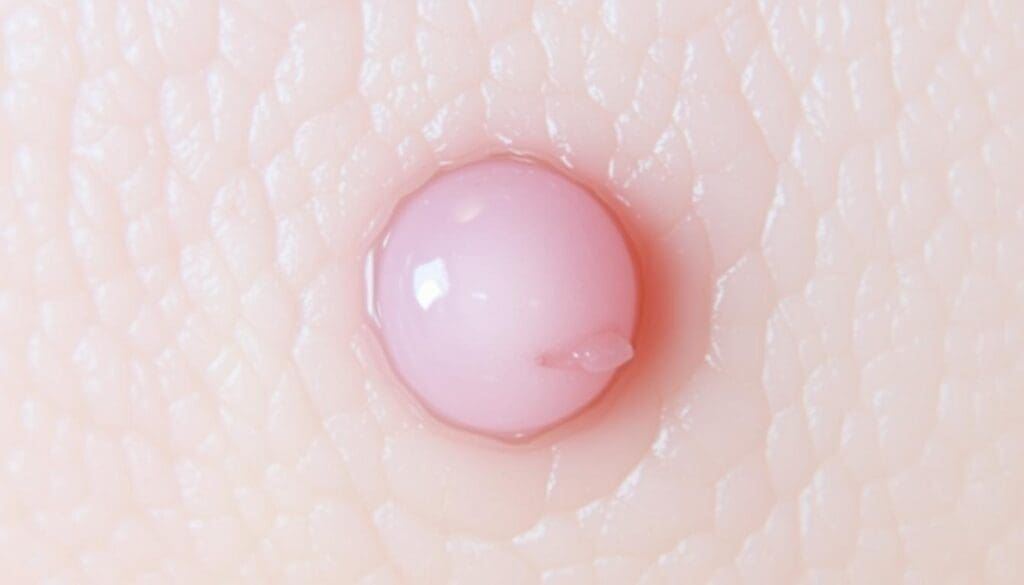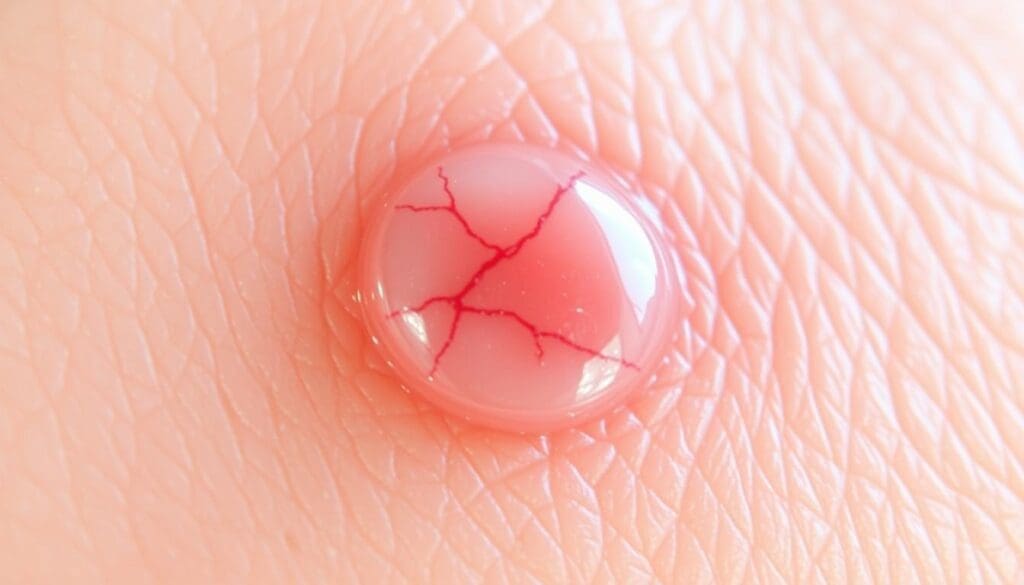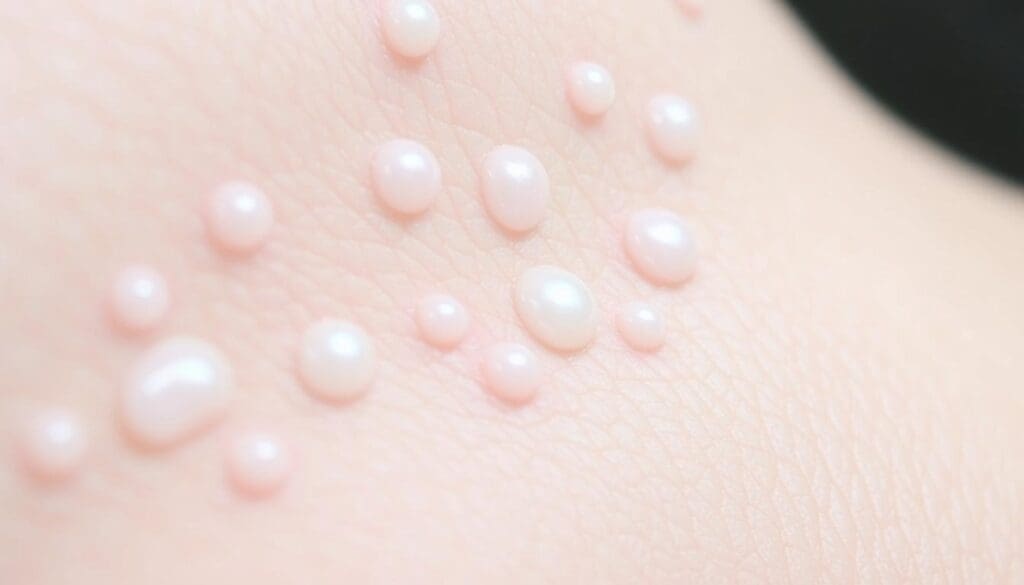Last Updated on November 27, 2025 by Ugurkan Demir

Basal cell carcinoma is the most common skin cancer. It shows up as translucent or pearly bumps on the skin. These bumps can look very different. At Liv Hospital, we stress the need to spot basal cell carcinoma early for the best treatment.
Basal cell carcinoma starts in the skin’s basal cells. It can look different each time. Knowing what it looks like is key to catching it early.
Spotting it early makes treatment work better. We focus on teaching patients and keeping them healthy. We share easy-to-understand info on recognizing skin cancer.

Basal cell carcinoma is the most common skin cancer. It’s important to know its causes and risk factors. This type of cancer affects many people around the world. We will look into what BCC is, how common it is, and what makes it develop.
Basal cell carcinoma starts in the basal cell layer of the skin. It happens when cells in this layer grow out of control. Studies show BCC makes up about 80% of all skin cancer cases.
“Basal cell carcinoma is the most common form of skin cancer, and its incidence is increasing worldwide.” This shows why knowing about BCC is key. It’s more common in people with fair skin, near the equator where the sun is stronger.
The main cause of basal cell carcinoma is UV radiation from the sun or tanning beds. UV radiation can damage skin cells’ DNA, causing mutations that lead to cancer. Several factors can increase your chance of getting BCC:
Knowing these risk factors helps prevent and catch BCC early. “The skin is our largest organ and acts as a barrier against external factors, including UV radiation,” so protecting it is vital. Use sunscreen, wear clothes, and seek shade to avoid UV rays.
By understanding basal cell carcinoma’s causes and risk factors, people can lower their risk. They should also get medical help if they see any unusual skin changes.

Basal cell carcinoma can look different, from small changes to big lesions. Knowing how it looks is key for catching it early and treating it right.
One common look of basal cell carcinoma is a pearly or translucent bump. These bumps are smooth and shiny, with blood vessels showing. They might look like a mole or a skin mark, but if they grow, it’s a sign of BCC.
Basal cell carcinoma can also show up as pink growths with raised edges and a sunken center. These might look like a sore or irritated skin. The edges are firm, and the center might be scaly or crusty.
In some cases, BCC looks like shiny nodules, which can be pink, red, or flesh-colored. These nodules might have dark spots or other skin changes. Because it can look different, it’s important to watch for any new or changing skin spots.
Basal cell carcinoma can also look like a scar-like lesion, making it hard to tell by just looking. These lesions might be flat or slightly indented, looking like a scar from an injury. But, if you notice a new scar-like mark without a clear reason, it’s best to see a dermatologist.
It’s important to know how basal cell carcinoma can look to catch it early. If you see any unusual or changing skin spots, see a dermatologist for a check-up.
It’s important to know the different types of basal cell carcinoma for the right treatment. Basal cell carcinoma (BCC) comes in several forms. Each has its own look and how serious it is.
Nodular BCC is the most common, making up 60-80% of cases. It looks like a pearly or translucent nodule with blood vessels. The edges roll and it might bleed or crust over time.
Superficial BCC looks like flat, reddish patches on the skin. It’s slow-growing and often found on the trunk or limbs. This type is less aggressive.
Morpheaform or morpheaic BCC is aggressive. It looks like flat, white, yellow, or waxy scar-like areas with shiny skin. It’s hard to diagnose because it looks like other skin issues.
Infiltrative BCC grows deep into the skin, making treatment hard. It looks like firm, whitish, or yellowish plaques without clear edges. This type can cause a lot of damage if not treated fast.
Doctors need to know these types to choose the best treatment. Each type looks different, and knowing this helps manage it better.
Knowing the early signs of basal cell carcinoma can help a lot. Basal cell carcinoma (BCC) often starts with small skin changes that are easy to miss. We’ll look at these early signs and how BCC can grow if not treated.
The first signs of basal cell carcinoma can look different on the skin. These signs may include:
As BCC grows, it can cause physical symptoms. These symptoms may include:
If not treated, basal cell carcinoma can grow and cause more harm. It can lead to:
| Stage | Description | Potential Complications |
| Early Stage | Small, localized lesion | Minimal damage if treated promptly |
| Advanced Stage | Lesion grows larger, potentially invading surrounding tissue | Increased risk of disfigurement and complications |
| Neglected Stage | Significant tissue destruction, potentially deep invasion | Severe disfigurement, serious health risks |
Early detection and treatment of basal cell carcinoma are key to avoiding these problems. Regular skin checks and visits to a dermatologist are important if you notice anything unusual.
Parts of the body that get a lot of sun are more likely to get basal cell carcinoma (BCC). BCC often shows up on skin that gets a lot of sun, like the face, head, and neck. It can also appear on the upper body and sometimes on parts that don’t get much sun.
The face and head are common places for BCC. This is because these areas get a lot of sun. Specific spots include:
BCC can also show up on the upper body. Common spots include:
| Body Region | Common Locations for BCC |
| Face and Head | Nose, Scalp, Ears |
| Upper Body | Neck, Chest, Shoulders, Back |
BCC can also appear in areas that don’t get much sun. These include:
Knowing where BCC often shows up can help catch it early. Regular skin checks and using sun protection are key to lowering BCC risk.
It’s important to know how basal cell carcinoma shows up in different skin types. This knowledge helps catch it early and treat it right. Basal cell carcinoma (BCC) is the most common skin cancer. It looks different on various skin tones.
In fair skin, BCC looks like pink or red bumps that might shine or look pearly. These spots can be flat or slightly raised. They might also have visible blood vessels.
On medium skin tones, BCC looks different than in fair skin. It often shows up as pigmented lesions, which can be brown or black. This can make it hard to tell apart from melanoma.
In darker skin, BCCs look like darker, pigmented growths. They can be tricky to spot because they might look like other skin issues.
Everyone should know the signs of BCC and see a dermatologist if they notice anything odd. Catching it early is the best way to treat it.
It’s important to tell Basal Cell Carcinoma apart from other skin issues. This is key for the right treatment. BCC can look like benign growths or other cancers, so knowing what to look for is vital.
Benign growths like seborrheic keratoses or moles can look like BCC. But there are clear differences:
If you’re not sure about a skin growth, see a dermatologist.
BCC is different from melanoma or squamous cell carcinoma. Here’s how:
Get medical help if you notice:
Early detection and diagnosis are key for effective treatment. If worried about a skin lesion, see a dermatologist.
Precancerous lesions, like actinic keratosis, often lead to basal cell carcinoma. These signs warn us that our skin might get worse. We’ll look at why spotting these early signs is key to stopping BCC before it starts.
Actinic keratosis is a common warning sign on the skin. It looks like rough, scaly patches, often from too much sun. Spotting actinic keratosis early is very important because it can turn into BCC or other cancers if not treated.
The change from a precancerous lesion to early BCC can take months to years. Watching how skin lesions grow, change color, or texture is key to catching BCC early. We suggest checking your skin often and seeing a doctor for any changes.
Keeping an eye on your skin is vital for catching BCC early. People who spend a lot of time in the sun or have other risk factors should watch for new or changing skin spots. Writing down any changes and seeing a dermatologist if you’re worried can help a lot.
By knowing about precancerous lesions and early BCC, we can act fast to prevent BCC. This can greatly lower the risk of getting basal cell carcinoma.
It’s important for patients and doctors to know about basal cell carcinoma diagnosis and treatment. Early detection and treatment can remove most basal cell carcinomas without issues.
A skin biopsy is usually the first step to diagnose basal cell carcinoma. It involves taking a sample of the suspicious area for a microscope check. This confirms if it’s basal cell carcinoma and what type it is.
Several methods are used to check basal cell carcinoma:
Surgery is often the main way to treat basal cell carcinoma. The aim is to remove the cancer fully while keeping as much healthy tissue as possible.
Here are some surgical methods:
For some, non-surgical treatments might be suggested. This is often for small tumors or those in sensitive areas.
Non-surgical options include:
Treating basal cell carcinoma is usually very successful, thanks to early detection and treatment. The treatment choice depends on the tumor’s size, location, type, and the patient’s health.
Most basal cell carcinomas can be cured with the right treatment. It’s key to follow up regularly to watch for any signs of new skin cancers or recurrence.
Knowing how basal cell carcinoma looks and its early signs is key. This knowledge helps in treating it early and avoiding serious problems. We’ve looked at the different types of basal cell carcinoma, their features, and where they often appear on the body.
Spotting it early is vital for a good outcome. Regular skin checks and knowing what basal cell carcinoma looks like can lead to early treatment. It’s important to watch for any changes in your skin and see a doctor if something looks off.
Understanding basal cell carcinoma is important. Knowing the risk factors, spotting early signs, and knowing the types of BCC helps protect your skin. Being informed lets you take care of your skin better.
Treatment is very important. Getting medical help quickly can greatly improve your chances of success and lower the risk of serious problems. We urge everyone to take care of their skin and see a doctor if they have any concerns about basal cell carcinoma or other skin issues.
Early signs of basal cell carcinoma include pearly or translucent bumps. Pink growths with raised edges and shiny nodules are also common. Scar-like lesions can also be a sign.
Basal cell carcinoma looks different on various skin types. On fair skin, it’s often pink or red. On darker skin, it might be brown or black. The look can change based on where it is and the type of BCC.
It often shows up on sun-exposed areas like the face and head. It can also appear on the upper body. Less often, it’s found on the trunk, arms, and legs.
Basal cell carcinoma has a unique look, like a pearly or translucent bump. It might bleed or crust. If unsure, seeing a dermatologist is key for a correct diagnosis.
Treatments include surgical excision, Mohs surgery, cryotherapy, and topical creams. The right treatment depends on the BCC’s type, size, and location, and the person’s health.
Yes, early detection and treatment can cure basal cell carcinoma. This approach improves outcomes and lowers the risk of complications.
Risk factors include fair skin, sunburn history, family skin cancer history, and UV radiation exposure. This includes the sun or tanning beds.
Protect your skin from the sun with sunscreen and protective clothing. Seek shade and avoid tanning beds. Regular skin checks are also important.
Nodular BCC looks like a bump or nodule. Superficial BCC is flat and pink or red. Nodular BCC grows slower than superficial BCC.
Yes, actinic keratosis is a precancerous lesion that can turn into basal cell carcinoma. Watching these lesions and getting medical help if they change is vital.
National Center for Biotechnology Information. (2025). What Does Basal Cell Carcinoma Look Like Early. Retrieved from https://pmc.ncbi.nlm.nih.gov/articles/PMC11720226
Subscribe to our e-newsletter to stay informed about the latest innovations in the world of health and exclusive offers!